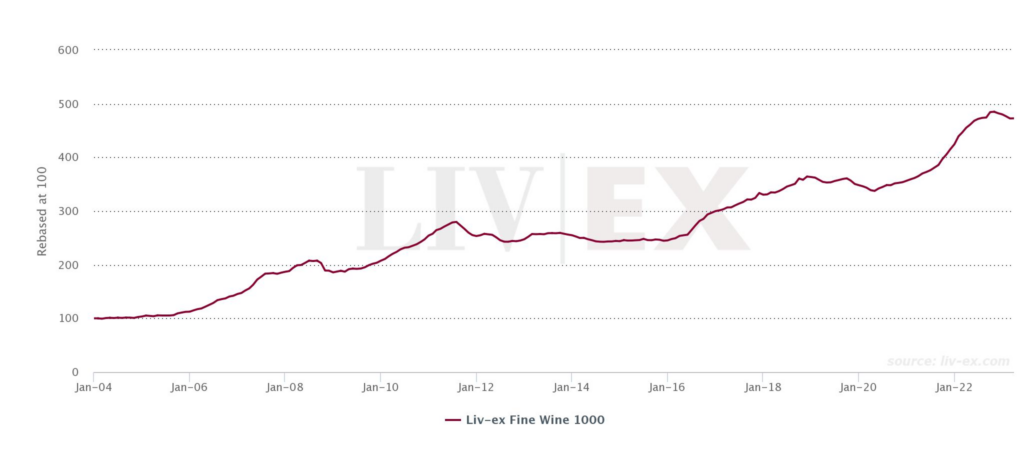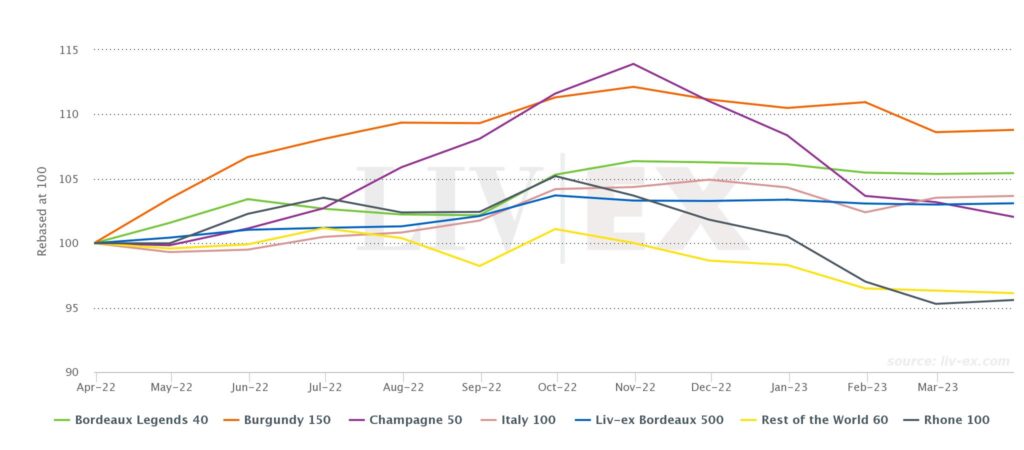- The Liv-ex Fine Wine 1000 index ran flat (0.0%) in March, halting a four-month decline.
- Most of its sub-indices also ran flat. The Rhone 100 was the biggest riser at just +0.3%.
- Champagne 50 was the worst performer, down 1.1%.

*made using the Liv-ex Charting Tool
The broadest measure of the secondary market, the Liv-ex Fine Wine 1000 index, ran flat (0.0%) in March, closing at 472.69.
Although this isn’t a positive change, it does put an end to the index’s four consecutive months of decline. Overall, the index is down 2.5% since October 2022. The Liv-ex Fine Wine 50, which tracks the movement of First Growths, fell by 0.2% in March.
This movement is in line with trade sentiment: over 50% of the respondents to our annual members’ survey described their outlook as neutral or pessimistic for 2023, a feeling echoed in the indices so far this year.
That being said, the secondary market is beginning to find its feet (albeit tentatively) after a slow start to the year. Trade was up by both value and volume this month, adding to February’s improvements. The market also broadened as 2,245 different wine labels (LWIN11s) traded – the highest monthly amount year-to-date.
The Liv-ex Fine Wine 100, the industry’s leading benchmark, also rose slightly by 0.2% in March for the second consecutive month. Although this is a small improvement on its previous four months of decline, it is not yet enough to correct the 1.85% loss recorded since October 2022.
The Champagne 50 falls for the fifth month in a row

*made using the Liv-ex Charting Tool

The Champagne 50 index has been falling for the past five months and is down 10.4% from its last high in November 2022, when it was the best-performing sub-index of the Liv-ex 1000.
The worst performers in the Champagne 50 in March were Salon Le Mesnil-sur-Oger Grand Cru 2006 (-11.9%), Taittinger Comtes de Champagne Blanc de Blancs 2011 (-8.7%) andJacques Selosse Millesime 2008 (-5.9%).
These three vintages are also the biggest fallers in the index year-to-date, with Jacques Selosse down 17%, closely followed by Salon (-16.7%) and Taittinger (-13.4%).
However, there were some positives within the index. For example, several champagnes from the 2012 vintage had a strong month. Philipponnat Clos des Goisses 2012 and Pol Roger Sir Winston Churchill 2012 both rose by 14.8% and 6.7% respectively. Sir Winston Churchill, in particular, featured three times in the top five performing champagnes in March, namely the 2012, 2013 and 2008.
Our recentpricing analysis of the Pol Roger Sir Winston Churchill 2015 release highlighted that the price of this wine tends to follow traditional patterns, whereby vintages appreciate in price with time.
What is the Liv-ex 1000 index?
The Liv-ex Fine Wine 1000 Index is broadest measure of the market. It represents the price movement of 1,000 of the most sought-after fine wines on the world’s most active and liquid marketplace. Stretching back over 20 years, the Liv-ex 1000 is comprised of seven sub-indices from across the world: the Bordeaux 500, the Bordeaux Legends 40, the Burgundy 150, the Champagne 50, the Rhone 100, the Italy 100 and the Rest of the World 60.
All Liv-ex indices are calculated using our Mid Price; the mid-point between the highest live bid and lowest live offer on the market. These are the firm commitments to buy and sell at that price; transactional data rather than list prices. It represents the actual trading activity of 600 of the world’s leading fine wine merchants. Because Liv-ex doesn’t itself trade, this data is truly independent and reliable.
Not a member of Liv-ex? Request a demo to see the exchange and a member of our team will be in touch with you shortly.
Liv-ex analysis is drawn from the world’s most comprehensive database of fine wine prices. The data reflects the real time activity of Liv-ex’s 600 merchant members from across the globe. Together they represent the largest pool of liquidity in the world – currently £80m of bids and offers across 16,000 wines. Independent data, direct from the market.





